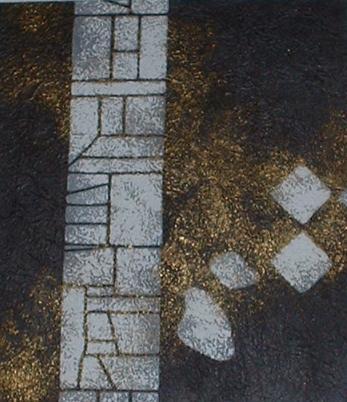Kyoto Diary : postscript
 One of the lovely coincidences on this visit, was that the hotel room I was staying in, had exactly the same painting on the wall that gave rise to the name of this blog. (Same hotel, different room) I tell the story in the very first post Its rough golden higlights still gleamed gently out over the room at night, like a gilded icon in a dark cathedral.
One of the lovely coincidences on this visit, was that the hotel room I was staying in, had exactly the same painting on the wall that gave rise to the name of this blog. (Same hotel, different room) I tell the story in the very first post Its rough golden higlights still gleamed gently out over the room at night, like a gilded icon in a dark cathedral.I felt that the trip had the atmosphere of a retreat. I feel that I managed to look quietly and deeply at the gardens and temples, and didnt hang on to the past impressions when it was a previously enjoyed place or event. And tried not to be attached to all the lovely new experiences either!
It was with gentle sadness that I learnt, on my return, that one of the members of our meditation group had died while I was away. A lovely young person, she was a shining example of how to live with joy while dying of cancer. I wonder if she died while I was watching this leaf dancing.
From "Peace is every step" by Thich Nhat Hanh
"One autumn day, I was was in a park, absorbed in the contemplation of a very small, beautiful leaf, shaped like a heart. Its color was almost red, and it was barely hanging on the branch, nearly ready to fall down. I spent a long time with it, and I asked the leaf a number of questions....
...... I asked the leaf whether it was frightened because it was autumn and the other leaves were falling. The leaf told me "No. During the whole spring and summer I was completely alive. I worked hard to help nourish the tree, and now much of me is in the tree. I am not limited by this form. I am also the whole tree. So I dont worry at all. As I leave this branch and float to the ground, I will wave to the tree and tell her "I will see you again very soon"
That day there was a wind blowing and, after a while, I saw the leaf leave the branch and float down to the soil, dancing joyfully, because as it floated it saw itself already there in the tree. It was so happy. I bowed my head, knowing that I have a lot to learn from that leaf."
...... I asked the leaf whether it was frightened because it was autumn and the other leaves were falling. The leaf told me "No. During the whole spring and summer I was completely alive. I worked hard to help nourish the tree, and now much of me is in the tree. I am not limited by this form. I am also the whole tree. So I dont worry at all. As I leave this branch and float to the ground, I will wave to the tree and tell her "I will see you again very soon"
That day there was a wind blowing and, after a while, I saw the leaf leave the branch and float down to the soil, dancing joyfully, because as it floated it saw itself already there in the tree. It was so happy. I bowed my head, knowing that I have a lot to learn from that leaf."





















































